Let me tell you a big secret. Although my parents hate it, I am a great fan of Gothic movies and Gothic fiction. Sometimes it is considered a part of the broader category of horror as “it tantalizes us with fear, both as its subject and its effect.” I must have seen “Frankenstein,” “Dr. Jekyll and Mr. Hyde,” and “Dracula” many, many times, and it never really loses its suspense and excitement for me.
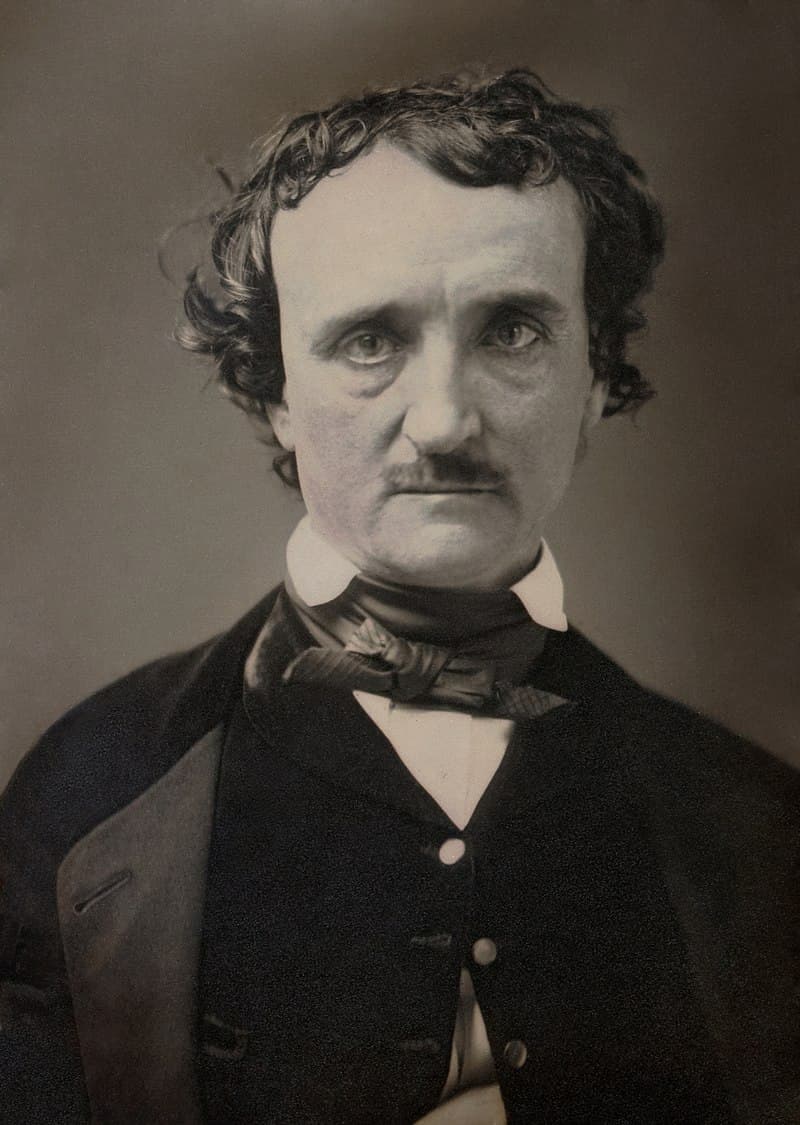
Edgar Allan Poe
I guess the early Victorian period is particularly famous for its gothic novels and poetry, and my all-time favorite writer is Edgar Allan Poe. And his probably best-known poem “The Raven” was first published in a collection of other poems on 29 January 1845. It immediately caught the imagination of the public, and “Poe achieved instant national fame with the publication of this melancholy evocation of lost love.”
Joseph Holbrooke: The Raven (Poem for Orchestra), Op. 25
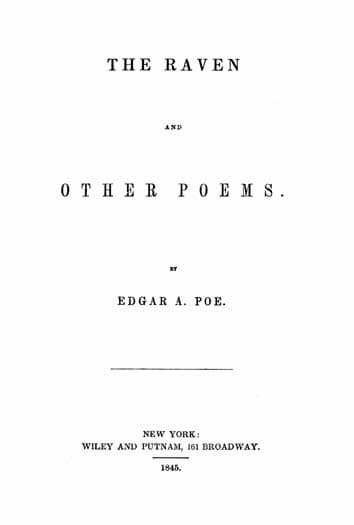
The Raven and Other Poems, Wiley and Putnam, New York, 1845
Poe takes us into the realm of psychology, and his influence is strongly felt in the music. A good many composers looked at Poe’s mix of the supernatural and symbolic as a source of musical dramatization. As the musicologist and conductor Leon Botstein writes, “The sense of affinity between Poe’s writings and music perhaps rests in the amorphous, abstract, yet psychologically powerful qualities of Poe’s dramatic illustrations, which seem to resemble the qualities of music itself.”
Joseph Holbrooke: The Raven (Poem for Orchestra), Op. 25 (Slovak Radio Symphony Orchestra; Adrian Leaper, cond.)
I read that the narrative poem “The Raven” is often noted for its musicality, stylized language, and supernatural atmosphere. And you can immediately sense that supernatural atmosphere in the first of 18 six-line stanzas.
Once upon a midnight dreary, while I pondered, weak and weary,
Over many a quaint and curious volume of forgotten lore—
While I nodded, nearly napping, suddenly there came a tapping,
As of someone gently rapping, rapping at my chamber door.
“’Tis some visitor,” I muttered, “tapping at my chamber door—
Only this and nothing more.”
Leonard Slatkin: The Raven
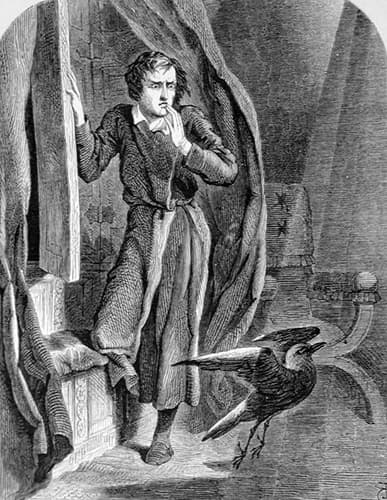
“The Raven” depicts a mysterious raven’s midnight visit to a mourning narrator,
as illustrated by John Tenniel (1858).
We learn that an unnamed narrator is reading “forgotten lore” by the dying fire on a dreary December night. Apparently, he is trying to forget the death of his beloved Lenore. The tapping at his chamber door reveals nothing, and when it is repeated he realizes that it is coming from this window. When he goes to investigate, a raven flutters into his chamber and perches itself on a bust of Pallas Athena above the door. Leonard Slatkin’s setting of The Raven is “almost like a concerto for speaker and orchestra.” It unfolds in five movements, the first four performed by the woodwind, percussion, brass, and string sections, respectively. The narration is spoken by Alec Baldwin, and in the final movement the timpani is playing a three-note motive to imitate the bird cawing, “Nevermore.”
Leonard Slatkin: The Raven (Alec Baldwin, narrator; Manhattan School of Music Symphony Orchestra; Leonard Slatkin, cond.)
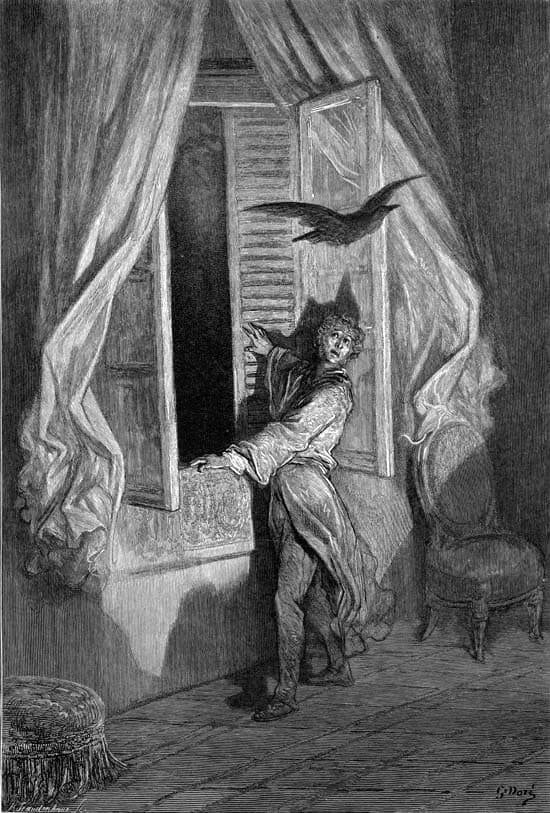
“Not the least obeisance made he” (7:3), as illustrated by Gustave Doré (1884)
In the poem, the Raven intrigues the narrator and he asks the bird to tell him its name. As we know already, the answer is “Nevermore.” Intrigued by the talking bird, the narrator asks a number of questions, about his life, about Lenore, and whether he will be reunited with her in heaven. As expected the Raven’s answer does not change and the narrator gets angry. He calls the raven a “thing of evil,” a “prophet,” and a “liar.” He tells the bird to fly away, but as we learn in the final stanza:
And the Raven, never flitting, still is sitting, still is sitting
On the pallid bust of Pallas just above my chamber door;
And his eyes have all the seeming of a demon’s that is dreaming,
And the lamp-light o’er him streaming throws his shadow on the floor;
And my soul from out that shadow that lies floating on the floor
Shall be lifted—nevermore!
Toshio Hosokawa: The Raven
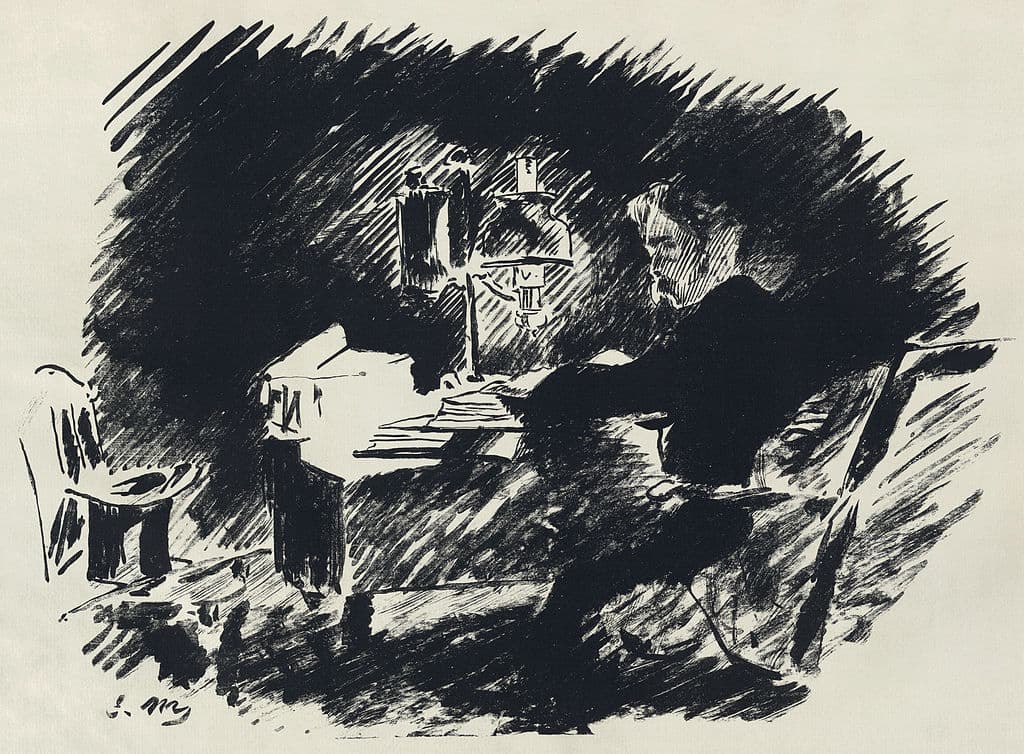
An illustration by Édouard Manet, from Mallarmé’s translation, depicting the first two lines of the poem.
The poet elected the raven as the central symbol of the narrative, “because he wanted a non-reasoning creature capable of speech.” Poe once mentioned that the raven is meant to symbolize “Mournful and Never-ending Remembrance.” For Japanese composer Toshio Hosokawa, “animals and plants often interact and converse with humans in traditional Japanese stories. There is no clear boundary between human beings and the natural world.” Hosokawa explains that “although the poem’s central character is originally a man, a woman speaks and sings in my monodrama.” Hosokawa uses female protagonists in many of his works, as they “act as shamans connecting this world and the spirit world.” In The Raven, the singer is both a shaman and a modern woman whose rational world collapses,” in this specific case it is Charlotte Hellekant, to whom the work is dedicated.
Toshio Hosokawa: The Raven (Charlotte Hellekant, mezzo-soprano; United Instruments of Lucilin; Kentaro Kawase, cond.)
Betsy Jolas: “Quoth the Raven”
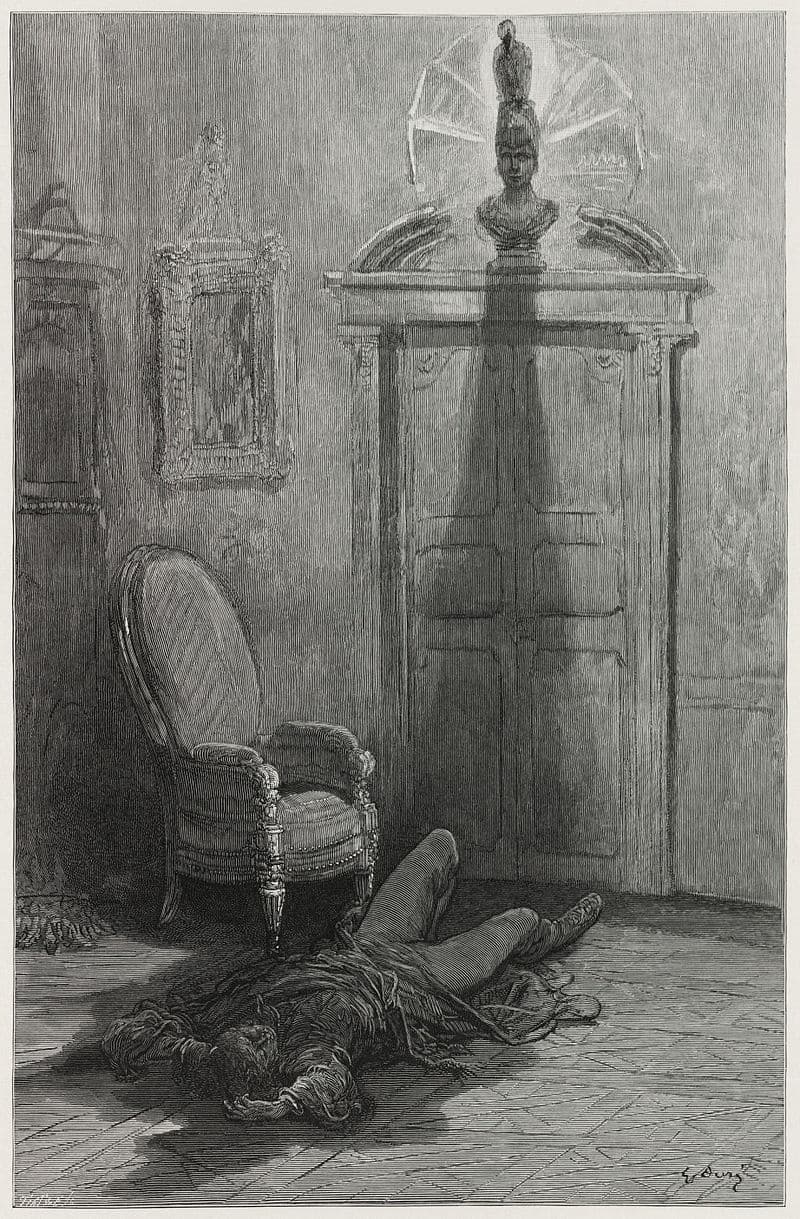
Gustave Doré’s illustration of the final lines of the poem accompanies the phrase “And my soul from out that shadow that lies floating on the floor/Shall be lifted—nevermore!”
Betsy Jolas was born in Paris in 1926 and took advanced studies with Darius Milhaud and Olivier Messiaen. A scholar writes, “Betsy Jolas belongs to a generation in which preoccupation with structural coherence, set forth in detail by the composers themselves in concert programmes, too often took precedence over the quality of the result in actual sound. Firm in her convictions, her will has always been to write fine music that defies explanation.” Her Quoth the Raven, whose title is borrowed from Edgar Allan Poe’s poem The Raven, was conceived for clarinet and piano. As she explains, “This peculiar group of three slow movements was written in 1993 upon the shock of the death of a very close friend […]. At the end of each movement, the raven’s sinister Nevermore is marked out in the manner of a cadence. Low-lying clusters (pools of indistinct sounds) are plentiful, but each piece has its own visage: morbid rocking intervals in the first, notes repeated like funereal chanting in the second, the urge to take flight in the last.”
For more of the best in classical music, sign up to our E-Newsletter
Betsy Jolas: “Quoth the Raven” (Laurent Camatte, viola; Geraldine Dutroncy, piano)

And what about the brilliant setting by Alan Parsons on his first album based completely on Edgar Allan Poe “Tales of Mystery and Imagination” https://www.youtube.com/watch?v=XA3A6TN6EgM